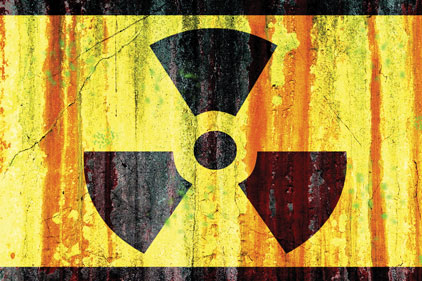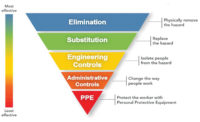Sometimes, the unexpected happens, and radioactive materials appear in places they should not be. Radioisotopes might be disposed of improperly, for instance. Or industrial imaging equipment could be recycled before the radioactive sources have been removed.
Why measure radiation dose?
Not all radiation exposure is dangerous, and some radiation doses are unavoidable. High doses of radiation, particularly during a short period of time, can cause adverse health effects, from burns and radiation sickness to an increased risk of cancer and even death in some cases. Chronic doses of radiation, doses received regularly over a long period of time, can also increase your risk of cancer.
The best way to reduce your risk of health effects from radiation is to keep your radiation dose As Low As Reasonably Achievable (ALARA). The basic principles of ALARA are time, distance and shielding. To reduce your radiation dose, you can shorten the time you spend near the radiation source, increase the distance between you and the radiation source, or place a shielding material between you and the radiation source.
Why use a dosimeter?
The most common radiation measurement devices are survey meters, isotope identifiers, personal radiation detectors, and dosimeters. Dosimeters are small, portable devices that measure cumulative radiation dose. The radiation sensors used in dosimeters are energy-compensated, which allows them to accurately measure the cumulative radiation dose a person receives.
Thermoluminescent dosimeters (TLDs) use a radiosensitive film to measure radiation dose. TLDs are often used to monitor and record radiation workers’ official quarterly and yearly dose and satisfy the basic regulatory monitoring requirements. However, TLDs cannot be read directly, and must be sent to a special facility on a regular basis to be processed. As a result, they are increasingly being supplemented with Electronic Personal Dosimeters (EPDs) to allow radiation workers to track their dose in real time on a daily basis and ensure that they are not receiving more radiation exposure than necessary.
Electronic Personal Dosimeters come in a variety of shapes and sizes, but all measure radiation dose and have a display that allows the wearer to track their dose in real time. Some EPDs also have alarm functionality, to alert the wearer if their dose has exceeded a predetermined limit. A few EPDs employ sensitive scintillator sensors to rapidly detect the lowest levels of radiation and provide an early warning of potentially unsafe radiation exposure. These devices provide a direct reading of both accumulated dose and dose rate to maximize the wearer’s protection against radiation exposure.
Most EPDs can be connected to a computer system to download dose and dose rate data, allowing cumulative dose to be easily tracked and monitored. Because of these features, EPDs are often used to monitor the dose for radiation workers in close proximity with radioisotopes and first responders who may be exposed to radiation during an operation.
How to measure your dose with a dosimeter
Measuring your dose with an EPD simply requires that the dosimeter be turned on and in dose monitoring mode while being worn on your body. The dosimeter continually and automatically measures the wearer’s accumulated dose, and stores the dose and dose rate data.
EPDs should be worn in the middle of the torso, under any jackets or coats. This location most effectively measures the dose to critical organs. Because the dose rate can vary greatly over a very small area, a dosimeter should never be placed in a jacket pocket or in a backpack, handbag or other clothing,
Many EPDs have user-programmable dose rate alarms built in, and can alert the wearer when they’ve entered an area where the dose rate is too high. If a user experiences a dose rate alarm while wearing a dosimeter, he or she should immediately retreat to an area where the radiation levels are lower.
Also, some EPDs have user-programmable total dose alarms to alert the wearer when they’ve received a predetermined dose limit. The dose limit alarm is typically set on a per-day or per-job basis. Setting the dose alarm threshold to a value slightly lower than the absolute total dose limit allows the wearer extra time to retreat to a low-radiation area if the alarm triggers.
Recording and managing your dose
Tracking and recording your accumulated radiation dose on a regular basis can help ensure that you do not receive a dangerously high acute or chronic dose. If you are required by federal regulations to wear a dosimeter at work, your employer should have a dose monitoring and management program in place, and you should follow those procedures for recording and managing your occupational dose. Most EPDs allow data transfer to a computer for dose management and recording purposes. Many also record additional information about total dose, dose rate and alarm status at regular user-defined intervals, and this data can be downloaded and accessed via spreadsheet or specialized dose management software.
Reduce your risk
Many industrial facilities, such as refineries and chemical and manufacturing plants, house radioactive materials in the forms of liquid level gauges, imaging and sterilization equipment. This equipment should not require personnel to be trained as radiation workers. Personnel entering areas where the radioactive material is stored should wear an Electronic Personal Dosimeter (EPD) to alert them to any leaking sources and high dose rate areas, and at least one survey meter should be on the premises to ensure that no sources are leaking, and that a safe dose rate is maintained around the sources.
Proper use of EPDs can reduce the risk of radiation-related health effects by monitoring and tracking dose rate on a daily basis to ensure that a worker isn’t exposed to dangerously high levels of radiation. The keys to radiation dose management are Know Your Dose and ALARA. With the right electronic dosimeter, and following the tenets of ALARA, real-time dose monitoring and management is easy and straightforward, and can help protect you and your community.



